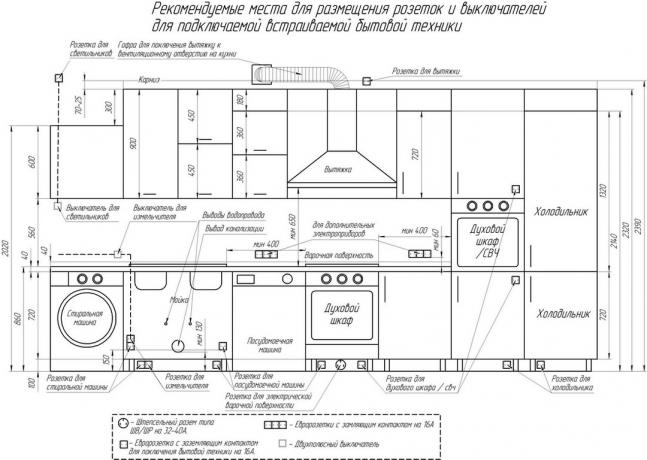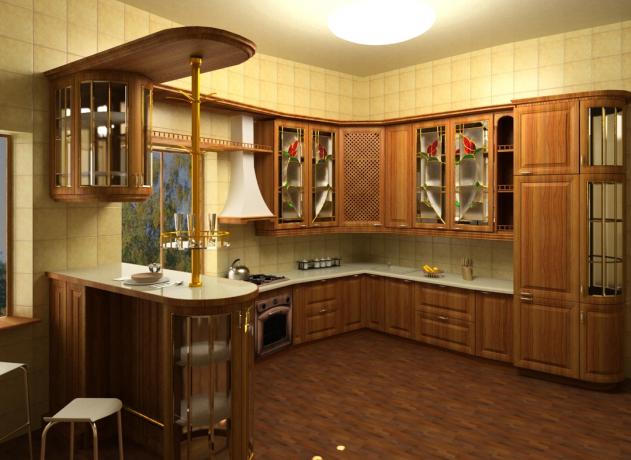Content
-
1 Who, where, why
- 1.1 The time has come
- 1.2 Installation issue
- 2 Finally
Modern kitchen is good because it allows you to fit everything that is intended for the kitchen and not only under a single tabletop. This technique has both practical application and is an excellent design solution. And to give completeness to the external design of the entire ensemble, so to speak, a finishing touch, there is and is very often used a plinth for the kitchen.
What it is, what it is used for, and how it happens, we will consider today.
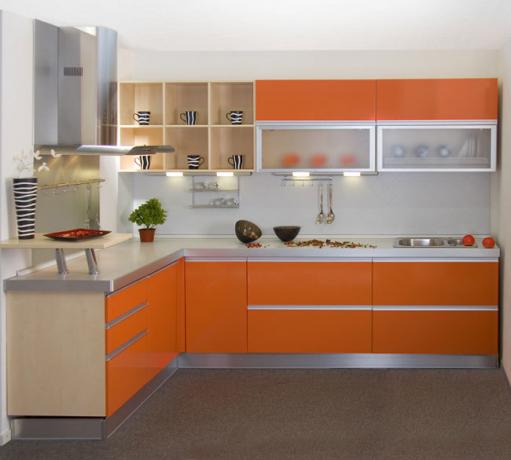
The metal base looks stylish.
Who, where, why
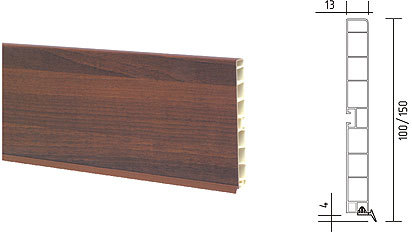
The plastic base is all over the face.
In simple terms, the base of the kitchen is the bottom bar on kitchen facadethat hides everything under the kitchen set. And taking into account the fact that today's material is a kind of instruction for use and selection, we give a more complete definition.
So, kitchen plinths are whole structures that consist of mandatory and additional elements.
- Mandatory elements include: a plinth strip for the kitchen, a seal and fastening strips with fixing clips;

Plastic bracket (clip) fastening.
- Additional elements include connecting elements that allow you to expose a structure with different-sized fragments connected to each other at a certain angle.
This also includes radius elements, which make it possible to abandon sharp corners and bring smoothness to the design.
Interesting to know!
There are three types of connectors, with angles of 90 degrees, 135 degrees and 180 degrees. They allow you to completely repeat the perimeter of any rectilinear surface of the kitchen set.

Connecting element.
The specified planks come in various heights. The plinth strip is available in three standard sizes.
The height of the kitchen base can be:
- 100 mm;
- 120 mm;
- 150 mm.
Note!
There are no special wisdoms here. Considering that the height of the legs of the kitchen set can be adjusted, the proposed sizes are more tailored to the tastes of the owners than to any technical features.
For example, it is believed that in kitchens with high ceilings, the basement should be high, and in standard kitchens with a height of 2.50, a 100 mm base will be enough.
The next criterion for dividing is the material from which the base is made.
For the production of such decoration elements used:
- Chipboard;
- Plastic;
- Aluminium alloy.
Note!
This division will be discussed in more detail in the next section, so as not to overload the introductory section with information.
The purpose of these strips is clear and transparent:
- They hide the space under the kitchen unit.
Note!
When installing a dishwasher and washing machine in the kitchen, the hoses for the water supply system and the drainage system are located in the above-mentioned space.
In large kitchens, this will be clearly visible. The solution to the problem of hiding these hoses is precisely in the plane of application of kitchen plinths.
- And second, they are the barrier that prevents the accumulation of debris and food debris under the curbstones. This point is very relevant for pet owners.

No debris, no dust - everything is closed.
The time has come
Indeed, the time has come to tell you about the materials from which the plinths are made, their advantages and disadvantages.
-
We start with the simplest and cheapest chipboard material.
Chipboard, and in the case of making plinths for the kitchen - chipboard (laminated chipboard) has a number of advantages that are quite significant if it is still used in the production of these products:

Chipboard product.
- The cheapest material, this characteristic is often decisive when choosing;
- The number of color solutions for laminate flooring in the kitchen can even argue with plastic;
- With proper care of the product, periodic drying and coating with a composition against mold and mildew, it can last a very long time and compete with both plastic and metal;
- Resistant to mechanical stress.
And about the disadvantages:
- The material is heavy and "clumsy", does not accept smooth shapes;
- No matter how carefully you manage in the kitchen, the base of the kitchen set made of chipboard will eventually begin to gain moisture and stratify at the ends, which will make the product look untidy. Most often, such a base is simply removed;
- The material does not tolerate moisture well, and the sudden temperature drops of the consequence are described above.
-
Now about plastic.
A plastic kitchen plinth has the following advantages:

And again, plastic.
- Ideal material in terms of price-quality ratio;
- Absolutely indifferent to moisture;
- Calmly withstands sudden temperature changes;
- Decently "holds the blow" (resistant to scratches, abrasion and other mechanical stress);
- Does not fade in the sun;
- Has a low weight, which allows you to remove the product for cleaning, even a child;
- The presence of connecting elements will allow you to install a plinth under any perimeter of the kitchen set.
Kitchen PVC plinth has a number of disadvantages, which are sometimes worth looking at:
- Although the plastic base has a fair amount of patience with the aggression of the kitchen environment, traces of dirt and streaks on it will be very noticeable, so you will have to take a rag in your hands more often;
- A plastic kitchen plinth does not like harsh detergents and cleaners, so choose gentle care products with a pH level closer to neutral;
- The next drawback is not an everyday one, and one could not mention it, but given our natural desire to highlight the proposed topic as much as possible, we will nevertheless mention it.
Note!
Although PVC material is heat resistant, it ignites at around 400 degrees Celsius, but it releases into the atmosphere when it burns. chemical substances that cause suffocation, therefore, in some countries, its use in child care facilities, hospitals, hospices, etc. introduced restrictions.
-
And about metal. An aluminum kitchen plinth has a number of advantages and a minimum of disadvantages.
Benefits:

Aluminum passions.
- Eco-friendly material, a leader in safety matters;
- Not afraid of temperatures, sun, water, steam... (in short, the character is Nordic, persistent);
- Extremely lightweight, both in weight and in assembly, disassembly;
- The austere appearance is perfect for classic kitchen models, as well as for kitchens designed in ultramodern style.
And about the disadvantages:
- The cost of this base will be the highest of all presented;
- Color scheme, everything is clear here.
Installation issue
If you knew how simple and easy it is to install a plinth structure, you would not google the question of how to install a plinth in the kitchen. Do-it-yourself assembly in a matter of minutes. To do this, we need glue or sealant for plastic or aluminum and a screwdriver with self-tapping screws for wood, for a chipboard base.
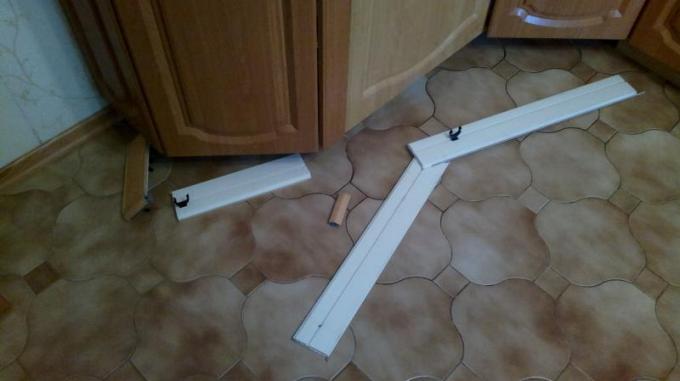
The fragments were prepared, the structure was assembled through adapters, the clips were inserted and that's it.
Note!
For chipboard fasteners, two self-tapping screws are provided for each. Therefore, we count the legs to which the clips will be attached, and multiply the resulting number by two.Advice! In different sources, you will find different recommendations on the number of mounts to be installed on the base.
Proceed from the calculated value of 50 centimeters, if the entire kitchen complex is displayed in one line.
If there are pedestals extending from the general line of furniture construction, then the fasteners must be fixed on each leg, where the structure forms an angle different from 180 degrees.
In total, there are two options for fixing the mount:
- Fastening with self-tapping screws, as when working with chipboard material;
- Locking in grooves.
In any case, the assembly and fixation is carried out in the following sequence:
- We put on a seal on the lower edge of the base, which can be fixed with a few drops of glue or sealant on plastic or aluminum and 8-12 mm nails to the chipboard;
- Then we bring the base to the legs and mark with a marker the place of fixing the base of the mount. For plastic and aluminum, special central grooves are provided for inserting such fasteners; on chipboard, the fastening base will have to be fixed with self-tapping screws;
- We spread the fasteners at the designated places, if necessary, fix them (as on chipboard) and, with a slight movement of the hand, insert the structure into a stationary place.
The curtain.
Finally
A plinth is essential in the kitchen, and it is in your power to turn it from a piece of metal, plastic or chipboard into a work of art, at least at home. And our photo and video selection will help you with this.
